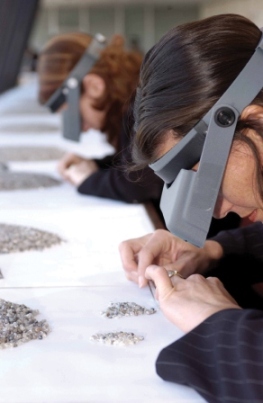Rough Update
October 27, 12
The unimaginable happened. Sightholders had to pinch themselves to make sure they were not dreaming. The Diamond Trading Company (DTC), De Beers' rough diamond marketing firm, actually lowered prices in August. This was a rare, atypical occasion.
Diamond miners, if they can help it, will not decrease prices. This is not as obvious as it may sound. The mining companies prefer to hold onto a larger rough inventory than lower prices. This is referred to in the market as having "a strong hand."
 The Argyle Pink Jubilee Image: Rio Tinto Diamonds |
Sightholders may disagree, but they have much more power in their hands then they give themselves credit for. The DTC is reacting to them far more then they realize. Look at what happened at the June Sight (Sight is the 10-times a year occasion when DTC sells rough).
Sightholders have the option to defer delivery of goods, changing their original request schedule (ITO – Intention To Offer) and they did so ahead of the June Sight. Sightholders can also ask for goods beyond their ITO (referred to as ex-plan), but refrained from such requests because of the low demand. This further decreased the amount of goods at the June Sight. A third option Sightholders exercised was leaving goods on the table. We understand that many Sightholders refused many of the boxes. One estimate is that as much as 15-20 percent of the goods were left on the table. As a result, the total value of the June Sight was estimated at less than $500 million.
In July, the DTC offered Sightholders the chance to defer up to 50 percent of their July allocations, and coupled with rejections and buy backs, the DTC July Sight was an even smaller Sight than that held in June, estimated at less than $400 million.
In addition, the full categories of goods were not sold at the July Sight: the Small Fancies, Cold & Brown Cleavage and Fancy boxes. In addition, several of the Fine boxes, such as the Collection goods, and a number of the Colored boxes were not sold.
However, prices at the July DTC Sight were not changed significantly. Some boxes were up, others down but the general policy of "price adjustments" remained intact.
 Rough Diamond Sorting and Grading at Harry Oppenheimer House in Kimberley Image: De Beers |
p/c, -2.1 percent) – all traded on the market at below the price Sightholders paid.
Further proving that the DTC prices were high, at BHP Billiton's auctions prices were down nearly across the board. The decreased supply to the market was a welcome move by many, mostly Sightholders. They did not like losing 5-15 percent on some of the goods they sold in the open market. What had in the past been a source of great income, this summer turned into a money pit.
At the August Sight, matters were already different. The DTC realized that without a price reduction goods would not sell and it responded accordingly. Price decreases of 8, 9, 12 and even 18 percent were seen at the Sight. Sightholders felt that their prayers, no less, were answered.
Outlook
Prices of rough diamonds fluctuate more than prices of polished diamonds. These fluctuations are at times to the detriment of manufacturers, although they have an influencing hand in this. Not so much on the direction of rough prices, which are determined by wider market forces, but more on the strength of the direction – how far will the price go. As polished diamonds start to head up under the warm light of the November-December selling season, manufacturers will quickly see that prices of rough, especially in the secondary market, start to rise too.
If retailers have a decent holiday season and turn to suppliers to replenish their stocks, then in January prices will increase to reflect the newfound demand.